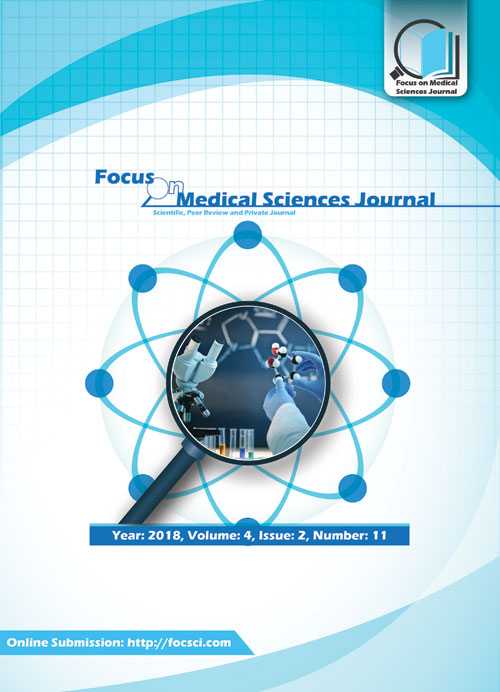فهرست مطالب
Focus on Science
Volume:1 Issue: 1, Oct-Dec 2015
- تاریخ انتشار: 1394/09/04
- تعداد عناوین: 7
-
Page 3IntroductionElectromagnetic radiation has irreparable biological effects on various tissues including testis. The use of antioxidants can greatly reduce the effects of this radiation and has anti-oxidant properties but their mechanism is not clear. Therefore, in the present study, protective effects of herbal extract of polygonum aviculare which are rich in antioxidants components examined on the expression levels of lipocalin 2.MethodsTwenty four male mice, 8 weeks divided to 4 groups (one control and three experimental groups). Control group didn’t receive EMF exposure. EMF group mice received 3 mT EMF during 2 months, 4 hours daily and 5 days weekly. Polygonum aviculare group received 50 mg/kg herbal extract during 2 months and poly -EMF group received 3 mT EMF during 2 months, 4 hours daily and 5 days weekly and 50mg/kg herbal extract during 2 months. After 2 months the mice sacrificed by cervical dislocation and samples prepared from the testis and immunofluorescent techniques was used to determine lipocalin 2 expression levels.Resultsthe result showed that lipocalin 2 expression was decreased in EMF group and increased in mice which had received herbal extract of polygonum aviculare.ConclusionsAs seen in the results, herbal extract increased lipocalin 2 expression and might act as a protective agent against free radicals induced by the action of electromagnetic field. Although, further studies are needed to acquire more knowledge about the mechanisms of these extracts.Keywords: EMF, Polygonum aviculare, Lipocalin 2, Testis
-
Page 4IntroductionPeer review is a process that will led to a decision for publication a manuscript in a journal or not. Peer review has some states and types. The aim of this study is going to define the process and clarify the author demands from journals to review their manuscripts.Materials And MethodsFor having a result in this study I have study and review more than 200 manuscripts’ peer review result and ask the authors about the satisfaction about reviewer’s comments on their manuscript. There are some points that all the journals and editors should take another look on them and of course there are some points that authors should take a look at them. Also peer review always make some serious problems for journals that some point to resolve these problem will discuss here.ResultsAccording to result of author survey of more than 40 medical journals, 85% of authors didn’t satisfied with comments left on their manuscript by editor and reviewers. Also peer review duration are not acceptable for most of authors. On the other hand editor had some complains about reviewers that do not respond to their invitations.ConclusionsPeer review process with strong and in time comments are a very important key for journals to attract the good authors and manuscripts. Peer review should not take a decision foe acceptance or rejection of a manuscript, in fact peer review should increase the validity and quality of the manuscript even if it would be rejected.Keywords: Peer Review, Research, Journal Article, Publications, Journalism, Medical
-
Page 5IntroductionThe enzyme, Phenylalanine dehydrogenase (L-phe DH; NAD oxidoreductase, deaminating; EC 1.4.1.20) belongs to the amino acid dehydrogenase family of enzymes which catalyzes the reversible oxidative deamination reaction of L-phenylalanine to their respective α- ketoacids. An assay technique with a high sensitivity for blood L-phenylalanine level, an important marker for the screening of Phenylketonuria (PKU), has been established by means of PheDH. This enzyme is being used as a commercial and valuable biocatalyst in medical and pharmaceutical industries. The enzymes of this family are closely related in structure and function.MethodsSwiss-Pdb Viewer used for analysis and Rhodococcus sp. M4 was chosen because of the availability of several crystal structures with bound substrates and its high specific activity.ResultsRhodococcus sp. M4 and B. badius PheDHs are very different from each other on a sequence level, sharing only %32 identity and %50 similarity. Coming from the same structural sub-family, they share a much stronger correlation in their folding motifs.ConclusionsSince there currently is no crystal structure available for the B. badius PheDH, the sequence was folded over the 1BW9 crystal structure and superimposedover the original scaffold using SuperPose.Keywords: Phenylalanine Dehydrogenase, α ketoacids, Structure, Function, SuperPose
-
Page 6IntroductionSepticemia is one of the main causes of morbidity and mortality worldwide that increases the hospitalization time and also raises the cost for patients. The current study aimed to evaluate the frequency and antimicrobial susceptibility profiles of blood culture isolates from the hemodialysis patients referred to Hasheminejad Hospital in Tehran, Iran.MethodsIn this retrospective cross-sectional study the records of 1090 patients who undergone hemodialysis in Hasheminejad Hospital Urinary Tract and Kidney Center between 2012 and 2013 were evaluated. At least two Blood samples from each patients were collected under sterile conditions and was injected into blood culture bottles. After 1, 3, 5 and 7 days, samples were cultured in sheep blood agar (BA), chocolate agar and eosin methylene blue agar (EMB). Disc diffusion on Muller Hinton Agar (HIMEDIA, India) was performed to define the susceptibility. Spss software version 20 was used to analyze the data.ResultsFrom 1090 patients 186 subjects had positive blood culture from them 121 were male and 65 were female. The most frequent isolated species are as follow respectively: coagulase positive Staphylococcus 68 (37%), Escherichia coli 47 (26%), Pseudomonas aeruginosa 25 (14%), Streptococcus Group D 22 (12%), Coagulase-negative Staphylococcus 13 (7%), Streptococcus group A 4 (2%), Klebsiella 2 (1%), and Bacillus 1 (1%). Gram negative bacteria were mostly sensitive to nitrofurantoin, amikacin, and ciprofloxacin. In addition, gram positive bacteria were mostly sensitive to vancomycin, amikacin, cefotaxime, ciprofloxacin, imidazole, colistin, erythromycin, and oflatoxin.ConclusionThe result of the current study determined the most prevalent bacteria that are responsible for septicemia in Tehran, Iran, and the most effective antimicrobials for treatment of septicemia in this area which could help physicians to select a proper antibiotics for initial antimicrobial therapy.Keywords: Anti, Bacterial Agents, Sepsis, Iran


